







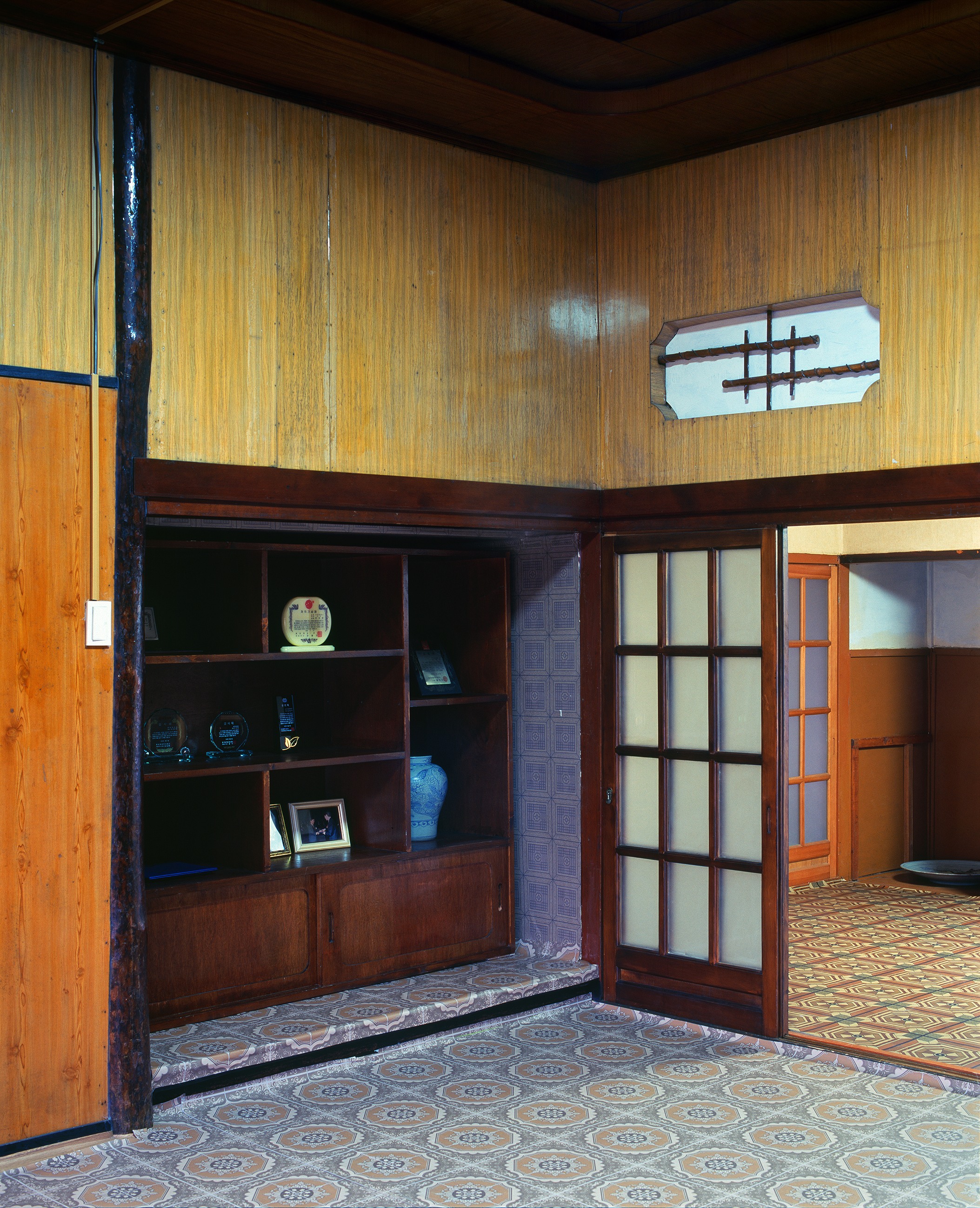



















Enemy Property (敵産)
A house is a space where people’s actions and culture accumulate, shaping—or even imposing—the structure of life. Since the opening of Joseon’s ports, most modern housing styles foreign to Korea’s traditional architecture were introduced through Japan. This process
served as both a conduit for modernity and a site of cultural collision and integration. In particular, Japanese-style houses built by the Japanese during the colonial period became U.S. military government property after Japan’s defeat in World War II. Known as enemy property houses (Jeoksan-gaok), they were later sold to Koreans by the U.S. military government and the Rhee Syngman administration. Over the past 70 years, these houses have undergone various transformations, shaped by historical necessities and individual needs. Although Jeoksan-gaok is often discussed in ideological and political terms, these houses—originally built with a Japanese framework—have been filled with the lives and cultural imprints of Koreans. This suggests that, rather than prioritizing ideology, history, or national identity in their homes, Koreans have placed the highest value on practicality. It also reveals that a house is not merely a symbol of history, but a form of life shaped by historical forces.
︎
적산(敵産)
집은 사람들의 행위와 문화가 쌓이는 공간이자 삶의 형태를 만드는 또는 강제하는 틀(구조)이다. 조선의 개항 이후, 과거 우리의 주거 양식과 다른 외래 근대주택 양식은 대부분 일본을 통해 들어왔다. 이는 근대가 우리에게 유입된 통로이자 축이 다른 문화가 상호 충돌, 융합하는 공간이라 말할 수 있다. 특히, 일제강점기 일본인에 의해 지어진 일식 가옥은 일본의 패전 이후 미군정 소유가 된다. 적의 재산, 즉 적산가옥(敵産家屋)이라 불리는 이 주택은 미군정, 이승만 정권에 의해 한국인에게 불하되었고, 이후 70여 년 동안 시대적 필요와 개인의 욕망에 따라 다양한 형태로 변화해 왔다. 적산가옥은 이념과 정치 언어로 호명되지만, 식민지 시기 일본인이 만든 뼈대에, 그 속은 한국인들의 행위와 문화의 결이 채워진 것이라 말할 수 있다. 이는 한국인이 집을 이념, 역사, 국가를 넘어 ‘실용’을 가장 최우선의 가치를 두고 살아왔다는 것을 말해줄 뿐만 아니라, 집이 시간과 행위가 축적된 역사를 상징하는 것을 넘어 역사가 만들어 낸 삶의 형태가 무엇인지 조망할 수 있게 한다.
︎︎
- This project had shown at Gwangju Biennale 2023 and Busan Biennale 2022. Please click the link for more information
- 14gwangjubiennale.com/#aboutAnchor
- busanbiennale2022.org/en
︎︎
︎
Production Period : 2018 - / Media : Digital c-print / Size Variable / Location : Incheon, Busan, Gwangju,
Jeongeup, Seoul, JInhae, Mokpo, Gunsan, South Korea / Number of Works : 35 +
Title (From the Top) : Busan (釜山) 01, Incheon (仁川) 71, Incheon(仁川) 72, Busan(釜山) 02, Busan(釜山) 05, Busan(釜山) 03, Busan(釜山) 04, Busan(釜山) 06, Busan(釜山) 07, Busan(釜山) 10, Gwangju(光州) 01, Gwangju(光州) 02, Busan(釜山) 12, Gwangju(光州) 03, Gwangju(光州) 04, Gwangju(光州) 05 Gwangju(光州) 07, Gwangju(光州) 076
Title (From the Top) : Busan (釜山) 01, Incheon (仁川) 71, Incheon(仁川) 72, Busan(釜山) 02, Busan(釜山) 05, Busan(釜山) 03, Busan(釜山) 04, Busan(釜山) 06, Busan(釜山) 07, Busan(釜山) 10, Gwangju(光州) 01, Gwangju(光州) 02, Busan(釜山) 12, Gwangju(光州) 03, Gwangju(光州) 04, Gwangju(光州) 05 Gwangju(光州) 07, Gwangju(光州) 076




















Prosperity (祈福)
The act of seeking prosperity through prayers for successful hunting, gathering, and farming can be considered a universal human practice. Eaves ornaments (Eocheoguni) on the palace roofs of the Joseon Dynasty, guardian mask tiles (Gwimyeonmangwa) on traditional Korean houses (Hanok), and paintings of the ten symbols of longevity (Sipjangsaengdo) hung inside homes can be viewed as acts of seeking prosperity, aimed at warding off misfortune and wishing for the health and longevity of the family. This tradition extends to the interiors and exteriors of modernized houses (such as Western-style houses, villas, and commercial-residential buildings) following traditional hanoks. In particular, symbols like the ten symbols of longevity (Sipjangsaeng) and the twelve zodiac animals (Sibiji) are commonly found on front gates, entrance doors, walls, and parking shutters, often created using cast iron or mortar techniques. Interestingly, these patterns sometimes draw directly from Buddhism and Taoism, and also incorporate and combine motifs found in Art Nouveau, mosques, Greek temples, and the traditional cultures of Korea, Japan, and China. This can be seen as a boundary-less culture of prosperity-seeking, where individuals and families blend many "sacred" elements across religions, nations, and eras for their own benefit. It serves as an example of how culture continuously evolves through people, transcending rigid frameworks of ethnicity and tradition.
︎
기복 (敵産)
인류가 성공적인 사냥, 수렵, 농사를 위해 하늘에 복을 기원하던 ‘기복’ 행위는 인류의 보편적인 행위라 말할 수 있다. 조선 시대의 궁 추녀마루 위의 어처구니, 한옥의 귀면망와, 집 내부 등에 걸어 놓던 십장생도 등은 집에 들어오는 악재를 막고 가족의 무병장수를 바라는 기복 행위라 말할 수 있다. 이는 전통 한옥 이후 근대화한 주택(양옥, 빌라, 상가주택 등)의 내·외부에 확장, 전이되는데 특히 대문, 현관문, 담벼락, 주차장 셔터 등에 십장생, 십이지 문양을 기본으로 주물, 모르타르 방식으로 자리한다. 흥미롭게도 이 문양은 불교, 도교의 것을 그대로 가지고 온 것도 있고 아르누보, 모스크 사원, 그리스 신전, 한국, 일본, 중국의 전통문화에서 발견되는 문양과 모티브를 차용하고 조합해 만들었다. 개인 또는 가족의 기복을 위해 종교, 국가, 시대를 넘어 ‘신성한’ 많은 것을 융합해 만든 경계 없는 기복 문화라 할 수 있다. 이는 민족, 전통이라는 딱딱한 틀을 넘어, 문화가 사람들에 의해 어떻게 끊임없이 변화하는지를 조망할 수 있는 사례라고 할 수 있다
︎︎
Production Period : 2022 - / Media : Pigment Print / Size Variable / Location : Incheon, Busan, Gwangju, Jeongeup, South Korea / Number of Works : 20 +
Title (From the Top) : Prosperity(祈福)01, Prosperity(祈福)03, Prosperity(祈福)04, Prosperity(祈福)02 / Installation View of ‘ Soft and Weak like Water ‘, the 14th Gwangju Biennale 2023.
Title (From the Top) : Prosperity(祈福)01, Prosperity(祈福)03, Prosperity(祈福)04, Prosperity(祈福)02 / Installation View of ‘ Soft and Weak like Water ‘, the 14th Gwangju Biennale 2023.






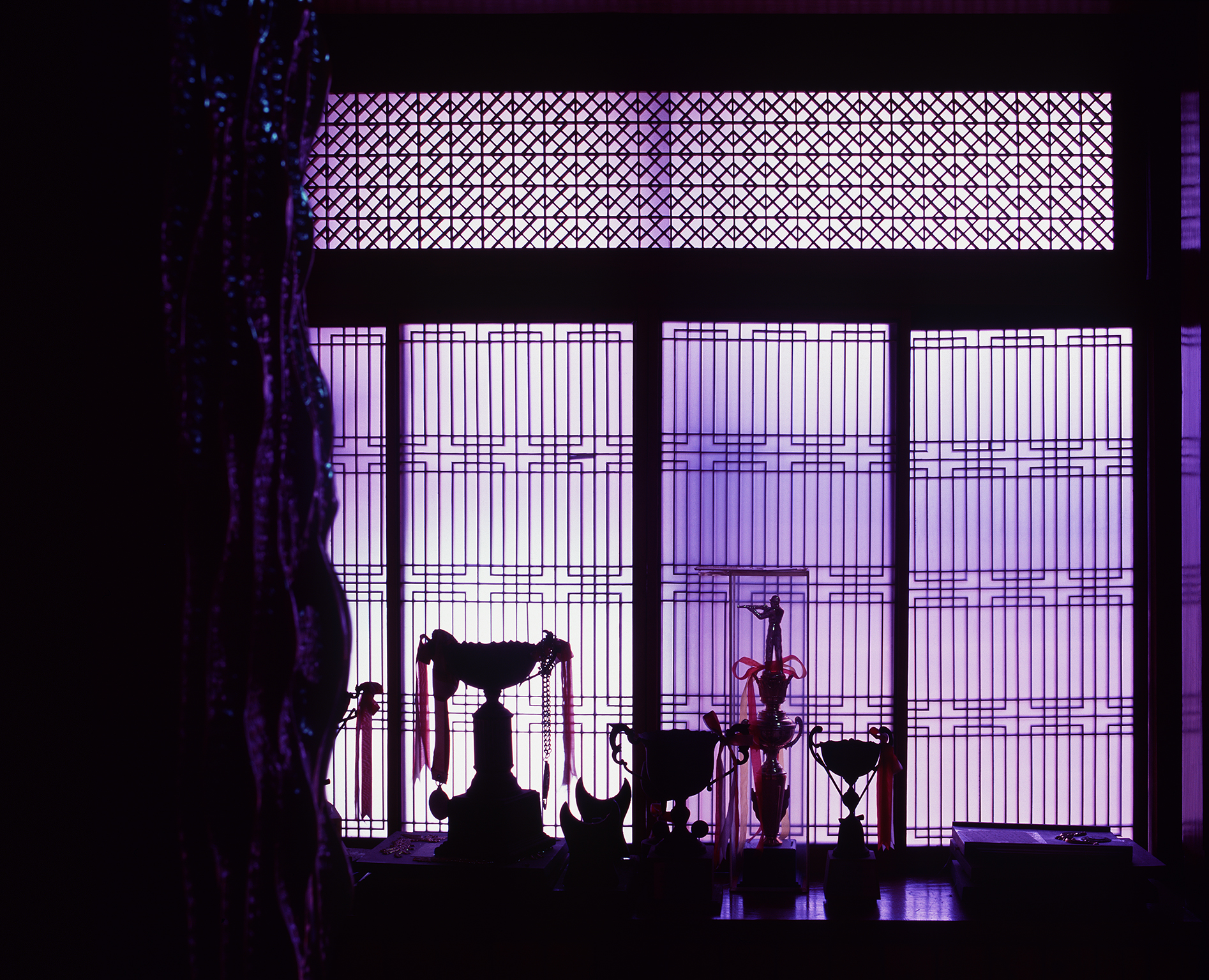














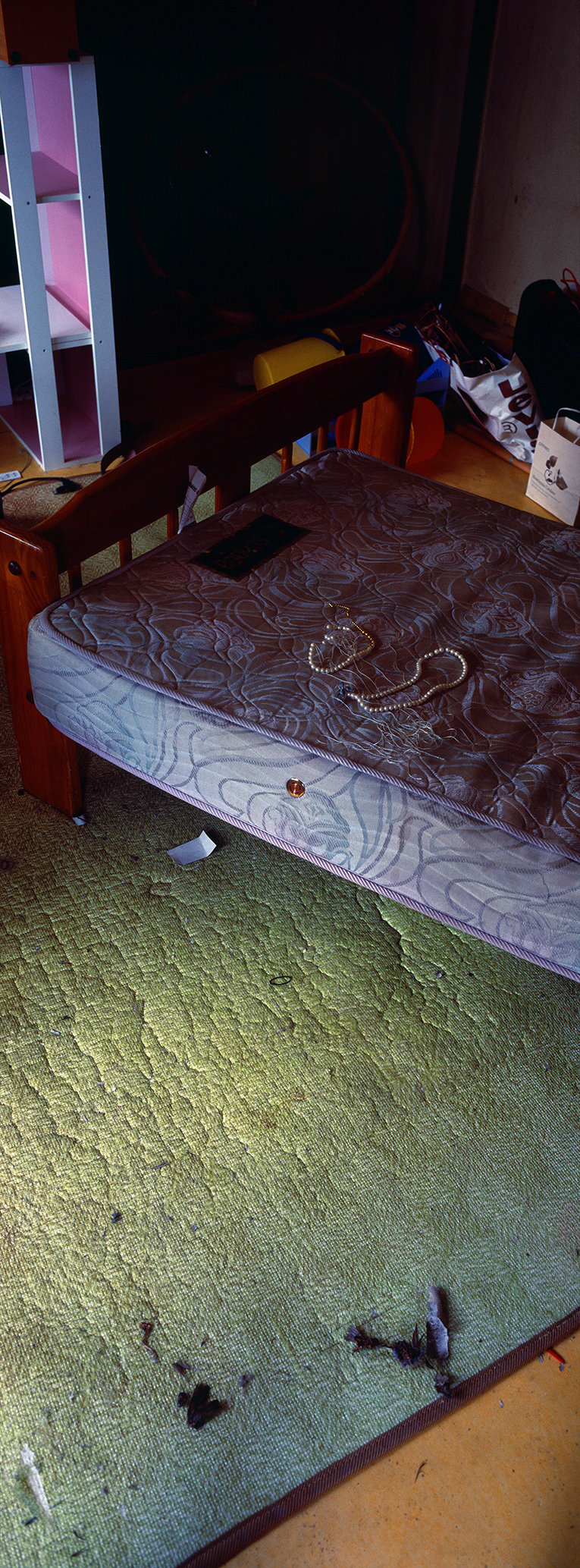









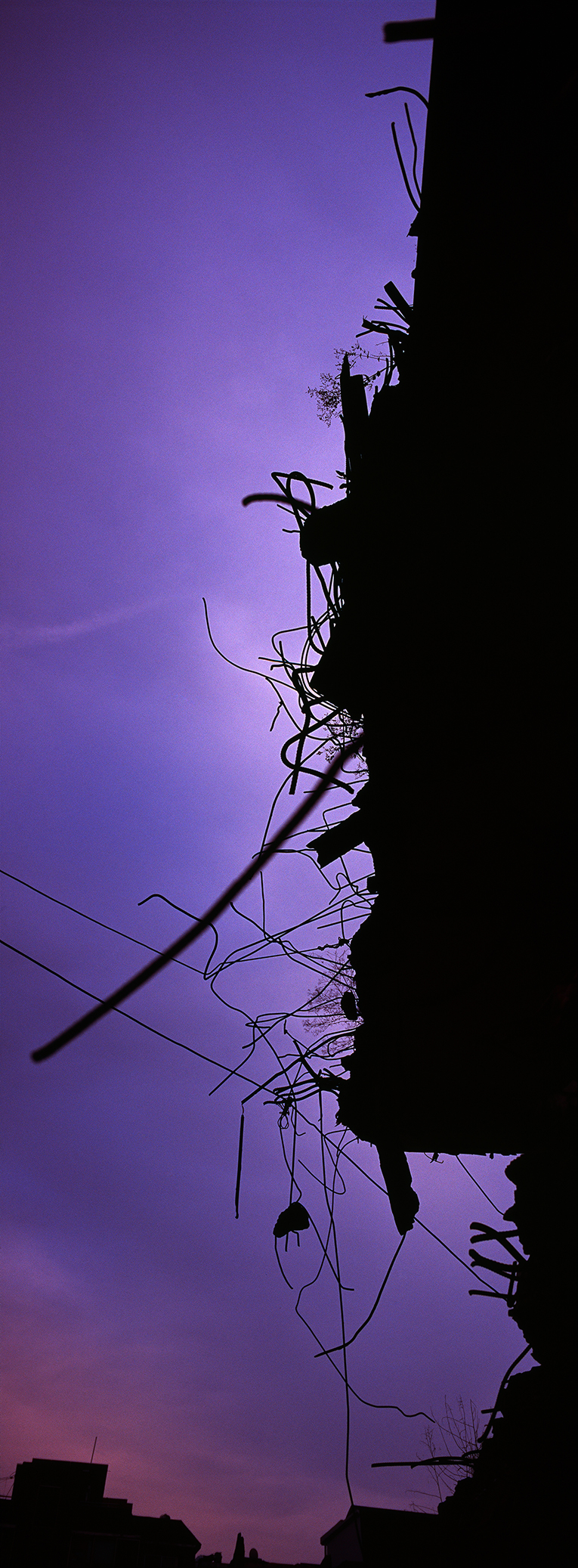













INCHEON (仁川)
Incheon was a cornerstone for Korea to step into modern times and had possibility to achieve a place that everybody can live together regardless of nationality. Plants and machines came to pass in various places in the city and dogged conflicts by people were followed not to be put under the influence of mechanization and confined life in a factory. After the Korean War in 1950 had claimed the lives of huge number of innocent civilians, north and south, two Koreas experienced the highly charged tensions of ideology under the temporal state of peace. Incheon witnessed a lot of mothers and fathers sacrificed their life and tradition and nature were damaged under the guise of development for the nation and industries.
Starting from the original landscapes of Incheon at the opening of its port, Project Incheon intends to project the images of time of the city and layers of memories accumulated from Japanese colonial era through Korean War to the period of industrialization. The images include Japanese houses extended and converted inside or outside with the times locating silently in old urban areas ubiquitously, odd structures with time and its own story in streets and alleys and Incheon Port and industrial sites which once had played a major role of modernization and industrialization but now ran their courses. Together, they have formed identities of Incheon as a city for a long time. If we put that a city is a human body, all these things were important organs that let the body alive. But now they became either obsolete or on the verge of extinction because they didn't seem to comply with the logic of capitalism or expiring of value. Time, memories and sites bearing history disappear unrealistically for good at the moment of extinction. Project Incheon demonstrates squarely identity of Incheon, on step further, that of Korea by capturing its major organs that had been accumulated and concealed over time and now being abandoned and might be so sooner or later.
︎
인천 (仁川)
도시 인천의 시공간을 중심으로 한국인들의 거주/생활문화를
기록하고 그 안에 각인된 역사를 연구한다.
‘인천은
근대가 첫 발을 내디뎠고 무국적의 가능성을 품었던 곳이었다. 지역
곳곳에 기계와 공장이 들어섰고 사람들은 기계화된 신체와 공장에 구속된 삶에서 벗어나기 위해 끈질긴 노동 운동을 이어왔다.
6.25전쟁이 전개되자 민간인들이 희생되었고 일시적인 평화의 상황
아래에서 남북이념의 터질 듯 한 긴장 속에 위치했다. 인천은 국가와 산업을 위해 전통, 자연, 아버지들과 어머니들의 삶이 희생된 곳이다.’
프로젝트
인천(仁川)은 개항과 더불어 근대 도시화 된 인천의 근원적인 풍경을
시작으로 일제강점기,
6.25전쟁, 산업화 등을 거치면서 축적된 도시의 시간과 기억의 층위를
사진으로 담아낸다. 그것은 원도심 곳곳에 숨죽이고 있는, 시대에 따라 증축, 변형된 적산가옥(Enemy Property)의
내.외부, 거리와 골목에서 목격할 수 있는, 시간과 역사를 담은 기이한 축적물 그리고 근대화, 산업화를 위해 지어졌지만 그 기능을 다한 인천내항과 각종 산업시설 등이다. 이 풍경들은 오랜 시간 도시 인천을 형성해 온 것들이며 각각의 시층에는 한국인의 거주/생활문화사가 각인되어 있다. 만약
도시가 하나의 신체라면 이 시층은 신체가 살아 움직이게 하는 중요한 기관들이라 할 수 있다. 본 프로젝트는 오랜 시간 은폐, 축적, 폐기된 또는 폐기될 도시 인천의 중요 이 신체기관을 사진으로
끄집어내 인천 더 넓게는 한국의 정체성과 그 안에 각인된 우리의 삶과 문화를 직시하고
증명하고자 한다.
︎︎
Production Period : 2018 - / Media : Digital c-print / Size Variable / Location : Incheon, South Korea / Number of Works : 55 +
Title (From the Top) : 02, 21, 27, 28, 46, 22, 52, 55, 29, 51, 31, 34, 36 ,26, 25, 57, 30, 35, 60, 32, 43, 33, 61, 47, 62, 63, 18, 54, 48, 44, 24, 37,, 39, 06, 64, 40, 07, 04, 20, 16, 05, 14, 38, 03, 23, 13, 01, 12









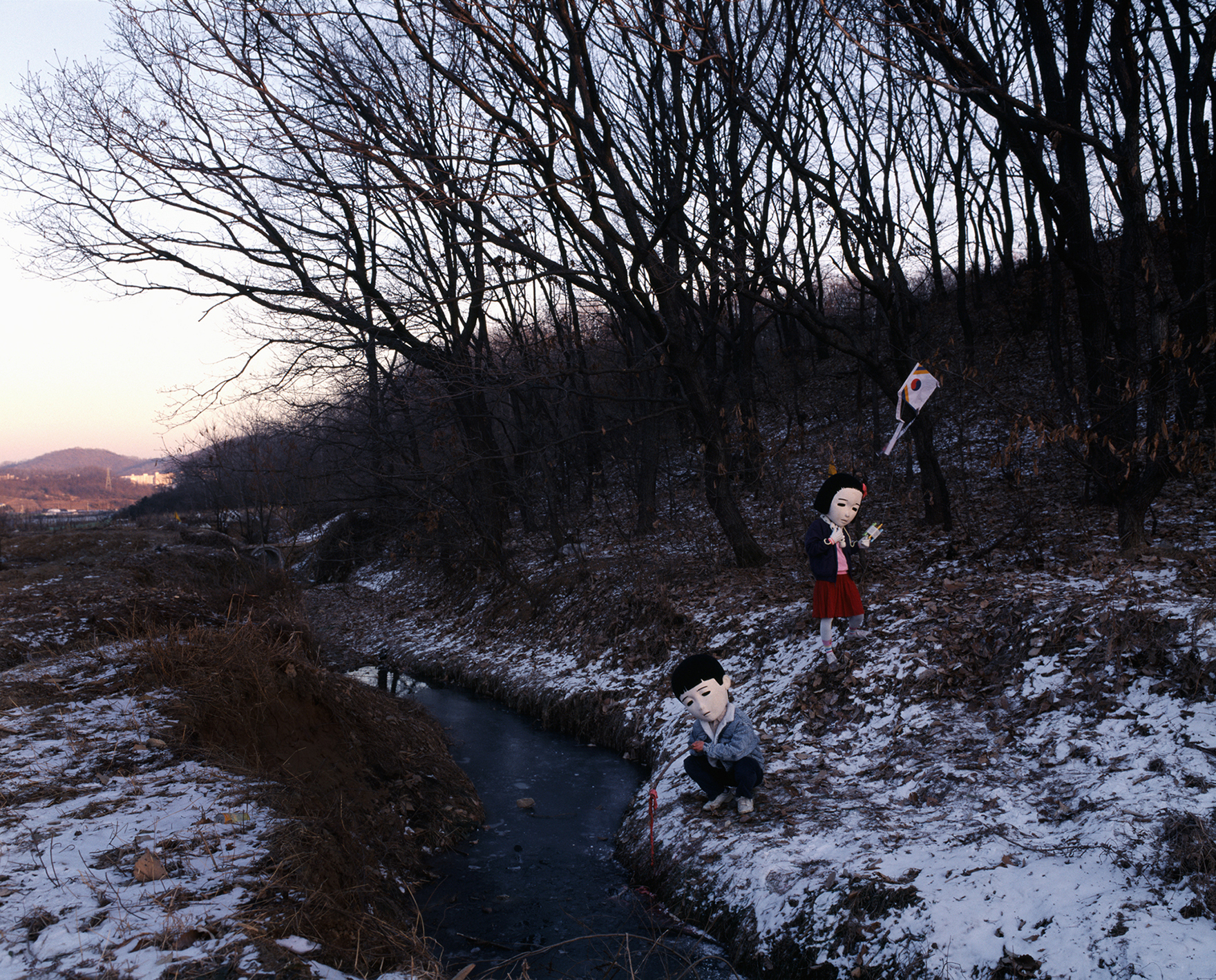








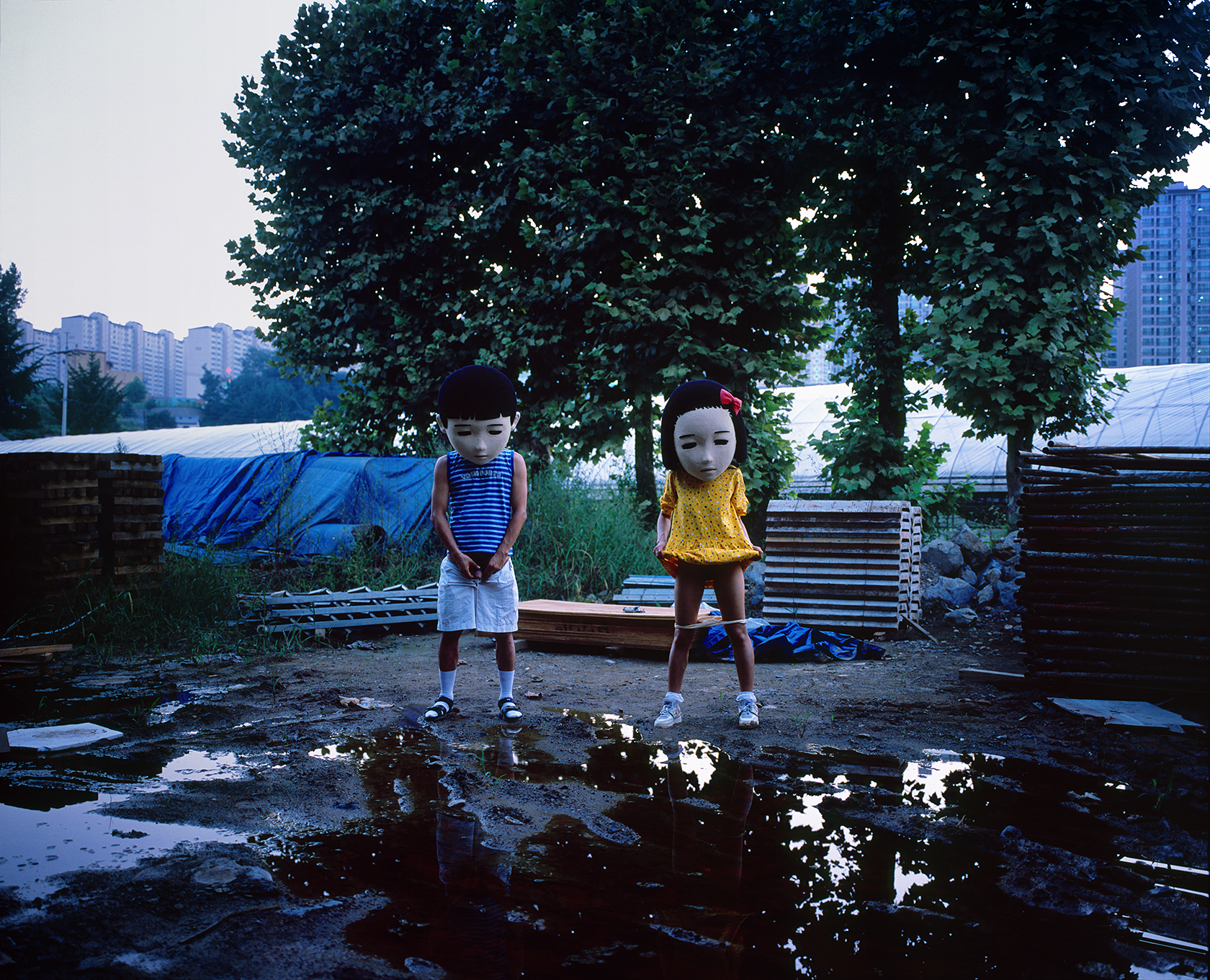


The Text Book (Chulsoo & Younghee)
Korean textbooks are full of didactic images meant to
educate children. But, in reality, for some reason our childhoods were filled
with strange and traumatic images. And those images somehow appear regularly in
our everyday lives and affect us for the rest of our lives. People with strange
memories from their childhood and I, a photographer, wore doll masks of the
main characters, Chulsoo and Younghee, who appear in these elementary textbooks
and we tried to recreate emotional moments from our past. And these emotional
moments were in turn recreated into the textbook that remains in the memories
of young Koreans who attended elementary school from the start of the 1970s to
the mid-1990s.
The story of Chulsoo and Younghee that appeared in our
elementary textbooks is about the memories from our youth and these memories
have great influence over our lives even now. It is difficult to identify why
we continue to be influenced by those memories, what their true nature is, and
what their underlying causes are. There are still so many times when we still
do not know how to dispel these memories, what the solution is, and what the
answer is. As a result, we torture ourselves over them, try to conceal them
from others and are tormented by them. What is more, there isn’t an instruction
manual that can be found from which we can refer to in order to overcome it,
and therefore, we cannot even imagine that the reason and solutions to those
incidents are close at hand. The sad reality is that from the memories that
they hold within their hearts, many people suffer from humiliation, guilt,
trauma, shock, and stress from which they cannot easily escape from. A possible
solution for this lies within an education (not just education taught at schools
but also overall social education and instruction) that is based on deep
understanding and consideration for people. Also, going beyond the structural
violence and typical way of narrow-minded thinking, there is need for wide
range of alternative philosophy and attention. All the images in this text book
(Chulsoo & Younghee) are the collection of ills that we as Koreans, and as
humans, have suffered, are suffering and will suffer in the future. These
images are also a personal analysis of the Korean society from the past to the
present that was done in order to overcome this collection of ills. Lastly,
these images are a counterproposal that passionately calls out to counterattack
society.
︎
교과서(철수와 영희)
대한민국 교과서에는 아이들을 계몽하는 이미지들로
가득하다. 그러나 현실적으로 볼 때 우리의 어린 시절은 어떠한 이유에서인지 기묘하거나 충격적인 이미지들로
채워져 있고 그러한 이미지들은 어떠한 계기를 통해 일상생활 안에서 주기적으로 나타나 우리에게 평생 영향을 미친다.
사진 작가인 나와 어린 시절의 기묘한 기억을 가진 사람들이 교과서 주인공인 철수와 영희의 인형탈을 쓰고 그 감정적인 순간을 함께 재구성하였고
이렇게 만들어진 순간은 1970년대 중반부터 1990년대까지
초등학교 시절을 보낸 대한민국 젊은이의 기억이 담긴 교과서로 재구성되었다.
교과서(철수와 영희)는 현재 우리에게 지대한 영향을 미치는 어린 시절의 기억에
대한 이야기이다. 우리는 왜 그러한 기억에 지속적으로 영향을 받는지
그것의 본질이 무엇이고 원인은 무엇인지 쉽게 찾지 못한다. 우린 이러한 기억을 아직까지도 어떻게 풀어야 하는지,
그러한 행위에 대한 해결책은 무엇인지 답을 가지지 못할 때가 많으며 스스로 자학하고 숨기며 괴로워할 때가 있다. 그리고 그것을 극복할 수 있는 매뉴얼 즉 그러한 사건의 이유와 해결방법이 아주 가까운 주변에 있다는 것을 생각하지
못한다. 많은 사람들이 여전히 가슴속에 자신의
기억으로 인해 인간으로서 가지는 모멸감, 죄의식, 트라우마, 충격, 스트레스를 받고 있으며 그것에서 쉽게 벗어나지 못하고 있는
건 슬픈 현실이다. 이러한 것의 해결책은 인간에 대한 깊은 사고와 이해가 바탕이 된 교육 (학교 교육 만이 아닌 사회 전반적인 학습, 습득)이 있어야 가능하다고 생각한다. 또한 사회 전반에 숨겨져 있는 구조적
폭력과 편협하고 전형적인 사고방식을 넘어서는 다양하고 대안적인 시선과 철학이 필요하다고 생각한다. 이
교과서(철수와 영희)의 모든 이미지는 한국인으로써 넓게는
인간으로써 우리가 겪었던, 겪고 있는 또는 겪을 열병의 집합체이며 이것을 극복하기 위한 과거부터 현재까지
대한민국 사회에 대한 개인의 분석이며 또한 대안을 가지고 사회에 반격하는 뜨거운 외침이기도 하다.
︎︎
Production Period : 2006-2008 / Media : Digital c-print / Location : Incheon & Bucheon / Number of Works : 23
Title (From the Top) : 1. p277, 100x124cm, 2008 / 2. p172, 60x73cm, 2007 / 3. p31, 26x32cm, 2006 / 4. Back Cover, 26x32cm, 2006 / 5. p151, 60x73 cm, 20076. p49, 26x32cm, 2006 / 7. p73 60x73 cm,2006 / 8. p127, 60x73cm, 2006 / 9. p73, 60x73cm, 2006 / 10. p191(Tear Gas),100x124cm, 2007 / 11. p163(Intestine) 100x124cm, 2007 / 12. p139, 60x73cm, 2007 / 13. Cover (Rock Scissors Paper), 26x32cm, 2006 / 14. p19, 26x32cm, 2006 / 15. p181, 60x73cm, 2007 / 16. Epilogue Page, 60x73cm, 2006 / 17. p37, 26x32cm, 2006 / 18. Prologue Page, 60x73cm, 2006 / 19. p94, 26x32cm, 2006 / 20. p291, 60x73cm, 2006 / 21. p239, 100x124cm, 2008 / 22. p269 100x124cm, 2008






Axis (軸) _
A Portrait of
Korean society that expressed as wounds on the body of a sex workers and
structures in a red-lights district
<Chug : Axis> started in Daegu and Incheon
where time and space of Korean society were heavily condensed. It began at two Dowondong
in Daegu and Incheon which harbors ‘Jagal-madang’ and ‘Yellow House’ (the
red-light districts established by imperial Japan). Shrines and their sites
that follow architectural style of Japanese imperial era were turned into
school and park. Also, there are many extended and transformed enemy’s house of
colonial Japanese era representing modern history of Korea. Two cities have many parallels to look and compare.
The purpose of <Chug> project was to
show rugged traces of modern and contemporary history of Korea starting from modernization
through Japanese colonial period, the Korean War, military dictatorship period,
industrialization period, to reign of neoliberalism. Capitalism had made a
fetish of women’s body cruelly and vulgarly and a state gave us damages and
wounds by using the crude feature of capitalism violently. All those wounds
left traces and they were accumulated and engraved not only on our bodies but
in time and space. <Chug> takes a form of triptych based on
condensational feature of photography. With accumulated layers of structures in
the red-light district and pain embedded in the body of sex workers, I try to
look squarely at the structure of Korean society.
︎
축(軸) _ 성매매 집결지 건축물과 성매매 여성의 신체에 축적된 역사와 상처로 보는 한국사회의 자화상
축(Chug)은
한국 사회의 시간과 공간이 강하게 압축된 인천과 대구를 중심으로 진행한 프로젝트이다.
자갈마당이
있는 대구 도원동,
나의
고향 인천 도원동
지명이 동일하듯 일제강점기에 지어진 대구와 인천의 신사는 각각 공원과 학교로 변화하였다.
또한 두
도시 모두 한국의 근∙현대사를
고스란히 표상하는 증축,
변형된
적산가옥이 도심 내 가득하며 일제가
조성한
유곽,
권번은
성매매집결지인
자갈마당으로 또 엘로우
하우스로
변화하였다.
근대화,
일제식민지,
한국전쟁,
군부독재,
산업화,
신자유주의로
이어지는 한국 근∙현대사의
험난한 궤적과 여성의 신체를 표백, 물신화한
자본주의 그리고 이를 이용한 국가폭력이 유발한 상처와
흔적은
우리의 신체뿐만
아니라 그것이 머물다 간 각각의 시공간에 축적되고 각인되었다. 축(Chug)은
사진이 가진 압축성을 바탕으로 세 장의 이미지가 하나의 작품이 되는 트립틱(Triptych)
방식을
활용하여 성매매집결지
건축물의 축적된 레이어와 성매매 여성의 몸에 축적된 아픔을 사진으로 담아 한국사회의 구조를 직시하고자 한다
︎︎
Production Period : 2016 - / Media : Digital c-print / Size Variable / Location : Daegu and Incheon, South Korea / Number of Works : 10+
Title (From the Top) : 01, 2016 / 02, 2016 / 03, 2017 / 04, 2017 / 05, 2017 / 06, 2018

